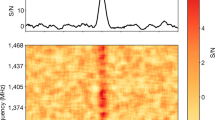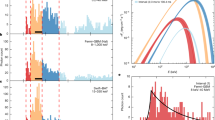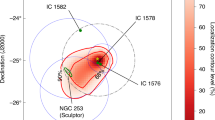Abstract
On 27 December 2004, just the third giant flare was observed from a magnetar, in this case SGR 1806-20. This giant flare was the most energetic of the three, and analysis of a Very Large Array observation of SGR 1806-20 after the giant flare revealed the existence of a new, bright, transient radio source at its position. Follow-up radio observations of this source determined that initially, this source underwent a mildly relativistic one-sided expansion which ceased at the same time as a temporary rebrightening of the radio source. These observational results imply that the radio emission is powered by ∼1024 g of baryonic material which was ejected off the surface on the neutron star during the giant flare.
Similar content being viewed by others
References
Cameron, P.B., Chandra, P., Ray, A., et al.: Nature 434, 1112 (2005)
Corbel, S., Eikenberry, S.S.: Astron. Astrophys. 419, 191 (2004)
Fender, R.P., Muxlow, T.W.B., Garrett, M.A., et al.: Mon. Not. Roy. Astron. Soc. 367, L6 (2006)
Feroci, M., Hurley, K., Duncan, R.C., et al.: Astrophys. J. 549, 1021 (2001)
Gaensler, B.M., Kouveliotou, C., Gelfand, J.D., et al.: Nature 434, 1104 (2005)
Gelfand, J.D., Lyubarsky, Y.E., Eichler, D., et al.: Astrophys. J. Lett. 634, L89 (2005)
Granot, J., Ramirez-Ruiz, E., Taylor, G.B., et al.: Astrophys. J. 638, 391 (2006)
Hurley, K., Boggs, S.E., Smith, D.M., et al.: Nature 434, 1098 (2005)
Lyutikov, M.: Mon. Not. Roy. Astron. Soc. 367, 1594 (2006)
Palmer, D.M., Barthelmy, S., Gehrels, N., et al.: Nature 434, 1107 (2005)
Taylor, G.B., Gelfand, J.D., Gaensler, B.M., et al.: Astrohys. J. Lett. 634, L93 (2005)
Thompson, C., Duncan, R.C.: Mon. Not. Roy. Astron. Soc. 275, 255 (1995)
Thompson, C., Duncan, R.C.: Astrophys. J. 561, 980 (2001)
Author information
Authors and Affiliations
Corresponding author
Rights and permissions
About this article
Cite this article
Gelfand, J.D. The radio nebula produced by the 27 December 2004 giant flare from SGR 1806-20. Astrophys Space Sci 308, 39–42 (2007). https://doi.org/10.1007/s10509-007-9317-y
Received:
Accepted:
Published:
Issue Date:
DOI: https://doi.org/10.1007/s10509-007-9317-y




